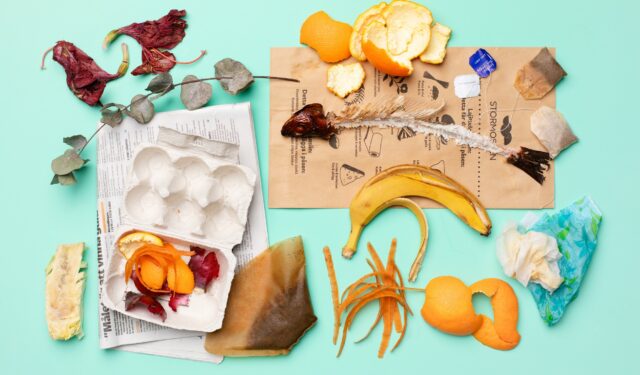Biowaste
Sorting biowaste enables a smart circulation of energy and nutrients. Biowaste sorting starts 1.10.2023 in most households on Stormossen operation area.
Biowaste is organic decomposing waste:
- leftovers
- spoiled food
- fruit and vegetable peelings
- animal innards and other waste
- solid fats
- liquid fats and cooking oil (absorbed in paper or in a sealed milk carton)
- coffee grounds and tea leaves
- filter paper
- kitchen towels, napkins, paper tissues
- bones
- plant parts, withered flowers, cut flowers
- egg packagings etc.
Why must biowaste be sorted?
When biowaste is sorted separately, it can be reused as raw material for compost soil and eco-friendly vehicle fuel in Stormossen’s biowaste plant. That way valuable energy and nutrients in the biowaste are smartly recycled. Biowaste does more harm than good amongst mixed waste (combustible waste) because wet waste reduces the energy value at Westenergy’s incineration plant.
Where is biowaste collected?
From October 2023 most households in Stormossen’s operating area in Vaasa, Korsholm, Vörå, Isokyrö, Malax, and Korsnäs begin sorting biowaste at their own property. If you live in a detached house, you can choose between your own biowaste container, a shared biowaste container with a neighbour, a multi-compartment container or a closed, isolated, and year-round compost.
If you live in a high-rise or row house with at least five homes, you already have had the possibility of sorting biowaste for years. Biowaste collection may become relevant for holiday homes in 2025 the earliest.
Advice for composters
If you have a closed and insulated compost that is used year-round, you can sort your biowaste into it. You can also share the compost with a neighbour. Bokashi is also allowed. In that case, post-composting in a closed compost is compulsory. You shall fill out a composting notification form at Vaasa Region’s Waste Committee’s (Vaasan seudun jätelautakunta) website (in Finnish).
You can read more about composting in Vaasa Region’s Waste Committee’s composting guide and in Marttojen kompostointiopas (in Finnish).
When sorting your biowaste in a compostor you don’t need paperbags for the waste since biowaste degrades better without a bag.
Which bag can I use?
Stormossen recommend using paper bags for biowaste. Stormossen’s own paper bags can be obtained free of charge from all our waste reception stations (including self-service stations), Vaasa Citizen Services (Teräksenkuja 1), Vaasa City library, Vähäkyrö Citizen Services, Ekosoppi (Hovioikeudenpuistikko 20), the Red Cross flea market in Vaasa, Retro Bazar in Sepänkylä, Korsholm head library, Minimossen, and Mikromossen. We are also handing out biowaste bags in following grocery stores; Sale Korsnäs, Sale Tervajoki, S-market Isokyrö. Please take only one sheaf so there will be some bags left for others too.
Other bag options:
- paper bag of folded newspapers
- empty flour bag, potato bag or other paper bag found at home
- envelopes without windows
We recommend paper bags because they decompose better than so-called bioplastic bags in the biowaste treatment process. Do not use regular plastic bags.
Tips for easy biowaste sorting:
- Let juices and other liquids (not oil) run into the drain. If possible, allow wet waste to dry for a while before putting it in the biowaste bag.
- You can place egg carton, kitchen towels, or newspapers at the bottom of the biowaste bag to soak up excess moisture. Also try to place egg carton in the bottom of the container under the bag for better ventilation.
- Change the bag after 2–3 days.
- Prevent bags from freezing in the container by putting the filled biowaste bag outside in a covered bucket to freeze separately. After that put the frozen bag in the biowaste container.
What happens to biowaste?
Biowaste is processed at Stormossen’s biogas plant to produce biogas and compost soil. Biogas is sold at our refuelling stations next to the waste management centre, Stormossenintie 3, and at the ABC Service Station in Runsor.
Compost soil is sold at the Sortaterminaali, close to Stormossen’s waste centre in Koivulahti. Watch this video how biowaste becomes vehicle gas at Stormossen.
Emptying of waste bins
If you live in Area A and sort your biowaste separately:
Emptying intervals for biowaste containers in detached houses and small apartment blocks is every other week in the summer (1 April – 30 October) and can be every fourth week in the winter (1 November – 31 March), or more frequently if needed. If you want to lengthen the emptying interval please contact info@stormossen.fi or call 010 3207600.
After 1 October 2023, property owners can agree directly with waste transporters on extended emptying intervals for mixed waste. In the future, emptying intervals for mixed waste can be as long as 12 weeks.
If you live in Area B and sort your biowaste voluntarily:
The emptying interval for mixed waste can be extended if biowaste is collected separately or composted. Biowaste container emptyings are ordered from Stormossen. A composting notification must be made to the Waste Committee. An extended emptying interval for mixed waste can be applied from Vaasa Region’s Waste Committee.
Check out postal codes in Area A and Area B.
All waste types
